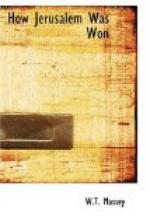The Desert Mounted Corps met with stubborn opposition in their operations south-east and east of Beersheba, but they were carried through no less successfully than those of the XXth Corps. The mounted men had had a busy time. General Ryrie’s 2nd Australian Light Horse Brigade and the Imperial Camel Corps Brigade had moved southwards on October 2, and on them and on the 1st and 2nd Field Squadrons Australian Engineers the bulk of the work fell of developing water and making and marking tracks which, in the sandy soil, became badly cut up. On the evening of October 30 the Anzac Mounted Division was at Asluj, the Australian Mounted Division at Khalasa, the 7th Mounted Brigade at Esani, Imperial Camel Brigade at Hiseia, and the Yeomanry Mounted Division in reserve at Shellal. The Anzac Division commanded by General Chaytor left Asluj during the night, and in a march of twenty-four miles round the south of Beersheba met with only slight opposition on the way to Bir el Hamam and Bir Salim abu Irgeig, between five and seven miles east of the town. The 2nd Australian Light Horse Brigade during the morning advanced north to take the high hill Tel el Sakaty, a little east of the Beersheba-Hebron road, which was captured at one o’clock, and the brigade then swept across the metalled road which was in quite fair condition, and which subsequently was of great service to us during the advance of one infantry division on Bethlehem and Jerusalem. The 1st Australian Light Horse Brigade commanded by General Cox, and the New Zealand Mounted Rifles Brigade under General Meldrum, moved against Tel el Saba, a 1000-feet hill which rises very precipitously on the northern bank of the wadi Saba, 4000 yards due east of Beersheba. Tel el Saba is believed to be the original site of Beersheba. It had been made into a strong redoubt and was well held by a substantial garrison adequately dug in and supported by nests of machine-gunners. The right bank of the wadi Khalil was also strongly held, and between the Hebron road and Tel el Saba some German machine-gunners in three houses offered determined opposition. The New Zealanders and a number of General Cox’s men crept up the wadi Saba, taking full advantage of the cover offered by the high banks, and formed up under the hill of Saba. They then dashed up the steep sides while the horse artillery lashed the crest with their fire, and driving the Turks from their trenches had captured the hill by three o’clock. At about the same time the 1st Light Horse Brigade suitably dealt with the machine-gunners in the houses. Much ground east of Beersheba had thus been made good, and the Hebron road was denied to the garrison of the town as a line of retreat. The Anzac Mounted Division was then reinforced by General Wilson’s 3rd Australian Light Horse Brigade, and by six P.M. the Division held a long crescent of hills from Point 970, a mile north of Beersheba, through Tel el Sakaty, round south-eastwards to Bir el Hamam.




